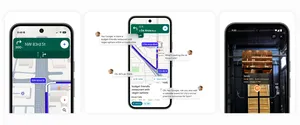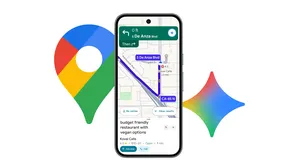How Street View helped a man discover a memory of his grandfather

A Street View frame shows a boxy white house in Porto, Portugal, with a terracotta roof, modest green lawn and long gray driveway stretching down its side. A figure can be seen at the driveway’s end, left knee on the cement and hands busy behind a small wheelbarrow, slightly blurred as if painted in watercolor.
For many, it would be an unremarkable image, but for Google software engineer André Santos it’s a treasure — one that might have stayed buried if not for a mix of fate, technology and curiosity.
In early 2023, André’s parents installed solar panels, and when the government announced €30 million worth of grants for people who had taken steps to make their homes more energy efficient, he decided to apply on their behalf. He just needed photographic proof the work took place after May 2022. “Getting the after photo would be easy enough,” André says. “But we didn’t have any past photos that clearly showed the outside of the house before.”
Recalling his time exploring neighborhoods he was considering moving into on Google Maps, an idea struck. “I remembered you could click on snapshots of past Street View images of an area,” André says. He took his laptop to his parents’ house and typed their address into Maps. The most recent image, from April 2023, already captured the solar panels on the roof, so he selected “see more dates” and found a picture taken in July 2022. Voila: no panels.
His parents, impressed by the feature, asked to see a before-and-after of a recent house renovation. André went further, clicking on the oldest available Street View image of the address from September 2009. As it loaded, his parents stopped talking; André, too, fell quiet. The trio’s eyes were drawn to that hazy figure at the back of the driveway. “It was my grandfather, Joaquim,” André says. “He’d passed away a year before.” André’s mom, who was especially close to her father-in-law, softly broke the silence: “I miss him.”
When André and his parents noticed his grandfather in this 2009 Street View image, they were stunned.
Street View officially launched in May 2007 with the goal of enabling people everywhere to virtually explore the world. As with so many products, people soon began using Street View in a range of ways. They visited potential vacation destinations and explored childhood neighborhoods. From 2014, when we introduced “Time Machine,” our unofficial name for the feature allowing you to explore previous years’ Street View panoramas, they were able to reach further and further back in time.
People made discoveries like André’s along the way. For instance, in 2015, a writer described in “The New Yorker” the moment he spotted his mother, who’d passed away two years before, walking up to her front door: "There was joy, certainly — ’Mom! I found you! Can you believe it?’ — but also deep, deep sadness….But almost immediately I realized how fortunate I was to have made the discovery.”
André echoes those feelings. “That was the first picture I’d seen of my grandfather since he passed,” he says. “I was speechless, but grateful.”
André’s grandfather, Joaquim Dias dos Santos (left) and young André with his grandfather.

Street View cars cover specific locations based on factors like how likely an area is to have changed since it was last photographed — a fast-developing city neighborhood may be re-shot more frequently than a rural area, for instance.
Today, some of those cars are mounted with our latest and most lightweight Street View camera, which captures richer data for more accurate and immersive 3D modeling, is about the size of a cat and has been rolling out since July. And with our latest Street View expansion, these cars are collecting imagery in more places than ever before.
The car that drove past André’s family home that sunny September afternoon in 2009 was a slightly clunkier affair. It was mounted with one of our earlier-generation units, its ring of eight outward-looking 5-megapixel cameras photographing the streets of Porto’s southern suburbs to a disk to later be sent to Google for processing, including the blurring of any faces and other data for privacy. Had Joaquim — then 72 and known to jokingly refer to his phone as a “microwave” — turned to see it drive by, he might have been astonished by its space-age look.
The previous generation Street View camera (left) and our latest camera.

André recalls what his grandfather was doing that day. Joaquim was a painter by trade and accomplished handyman who had built the house himself from the ground up. The family lived with their grandparents there and, as André and his sister entered adulthood, parking at the narrow end of the driveway got to be tricky. If one person needed to leave, everyone might have to move their cars to make way. Joaquim was building a wider parking area to help.
“The Street View car caught my grandfather in the moment doing something he loved — and it was for us,” André says. “I see that picture and I think, yeah, that’s him.”






